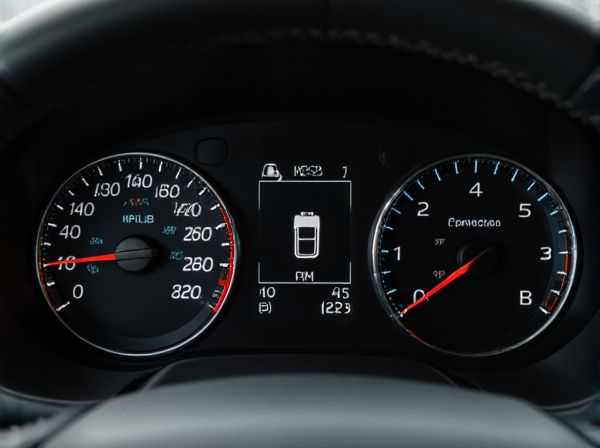
Photo illustration: Analog Fuel Gauge vs Digital Fuel Gauge
Analog fuel gauges provide a continuous, easily interpretable display of fuel levels through a needle on a dial, allowing you to quickly gauge how much fuel remains at a glance. Digital fuel gauges offer precise numerical readings or graphical bars, enhancing accuracy and reducing ambiguity during driving. Choosing between analog and digital fuel gauges depends on your preference for classic simplicity or modern data clarity in monitoring your vehicle's fuel status.
Table of Comparison
| Feature | Analog Fuel Gauge | Digital Fuel Gauge |
|---|---|---|
| Display Type | Mechanical needle on dial | Digital numeric or bar display |
| Accuracy | Moderate; needle positioning can be imprecise | High; precise fuel level readings |
| Readability | Easy but can be affected by lighting | Clear and visible in low light or bright conditions |
| Durability | Long-lasting; minimal electronic parts | Depends on electronic components; possible failure |
| Maintenance | Simple; fewer parts to repair | Complex; may require electronic diagnostics |
| Cost | Lower; traditional technology | Higher; advanced display technology |
| Integration | Standalone gauge | Can connect to digital dashboards and apps |
Introduction to Fuel Gauges
Fuel gauges measure the amount of fuel in a vehicle's tank, with analog fuel gauges displaying fuel levels through a mechanical needle on a dial and digital fuel gauges presenting accurate numerical readings on an electronic screen. Analog gauges rely on a float mechanism linked to a variable resistor, providing a continuous and intuitive visual representation of fuel status. Digital fuel gauges use sensors and microprocessors to deliver precise and easily readable fuel data, often integrating with digital dashboards for enhanced vehicle monitoring.
How Analog Fuel Gauges Work
Analog fuel gauges operate using a float connected to a variable resistor, which changes electrical resistance based on the fuel level in the tank. The resistance variation controls the current flowing through the gauge needle, causing it to move and indicate the fuel level. This mechanical-electrical system offers a continuous, real-time display without relying on digital circuitry or sensors.
How Digital Fuel Gauges Function
Digital fuel gauges function by using sensors to measure the fuel level and then converting these readings into electronic signals that are processed by a microcontroller or digital display unit. These gauges provide precise and real-time fuel level data, often integrating with vehicle onboard diagnostics to offer accurate monitoring and alerts. Compared to analog gauges, digital systems minimize human error by displaying exact numerical values or graphical indicators, enhancing fuel management efficiency.
Accuracy: Analog vs Digital
Digital fuel gauges offer higher accuracy by providing precise numerical readings and real-time updates, reducing estimation errors commonly found in analog gauges. Analog fuel gauges rely on mechanical sensors and needle positions, which can be affected by vibrations and sensor wear, resulting in less precise fuel level indication. Advanced digital systems often integrate with vehicle diagnostics, enhancing accuracy through continuous calibration and error correction.
Readability and User Experience
Analog fuel gauges provide a quick visual reference through a needle pointing to fuel levels, making it easier to interpret at a glance, especially when driving. Digital fuel gauges offer precise numerical readouts, enhancing accuracy but sometimes requiring more attention to read. User experience favors analog for intuitive understanding and digital for detailed monitoring, depending on driver preference and vehicle design.
Durability and Reliability
Analog fuel gauges typically offer greater durability due to their simpler mechanical components, which are less prone to electronic failure in harsh environments. Digital fuel gauges depend on electronic sensors and circuits that may be more sensitive to moisture, temperature fluctuations, and electrical issues, potentially reducing long-term reliability. However, advancements in sealed electronics and robust sensor technology are steadily improving the resilience of digital fuel gauges in modern vehicles.
Cost Comparison
Analog fuel gauges typically cost less upfront due to simpler mechanical components and widespread availability, making them a budget-friendly choice for basic fuel level monitoring. Digital fuel gauges involve higher initial expenses because of advanced electronics, sensors, and display technology, but provide precise readings and integration with vehicle diagnostics. Maintenance costs for analog gauges remain lower, whereas digital systems may incur additional repair or calibration fees over time due to their complexity.
Maintenance and Calibration
Analog fuel gauges typically require more frequent maintenance and manual calibration due to their mechanical components that can wear out or drift over time, leading to inaccurate readings. Digital fuel gauges, powered by microprocessors and sensors, offer more precise measurements with minimal calibration needs and are less prone to mechanical failure. Routine software updates and sensor calibrations enhance the accuracy and reliability of digital gauges, reducing long-term maintenance costs compared to analog systems.
Application in Modern Vehicles
Modern vehicles increasingly utilize digital fuel gauges due to their higher accuracy, real-time data processing, and integration with onboard diagnostics systems. Analog fuel gauges remain common in budget or classic vehicles, offering simplicity and ease of repair but lack precise fuel level readings. Digital gauges enhance driver awareness by providing exact fuel consumption metrics and alerts, improving fuel management and overall vehicle efficiency.
Choosing the Right Fuel Gauge
Choosing the right fuel gauge depends on accuracy, readability, and vehicle compatibility; analog fuel gauges provide a quick visual reference through a moving needle, ideal for classic cars and simplicity, while digital fuel gauges offer precise fuel level readings, often with additional features like fuel consumption data and alerts. Consider vehicle type and driver preference: analog gauges work best for straightforward monitoring, whereas digital gauges enhance functionality with clear numerical displays and integration with modern vehicle systems. Evaluating fuel gauge technology ensures optimal performance and driver confidence in fuel management.
 caratoz.com
caratoz.com